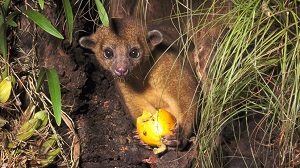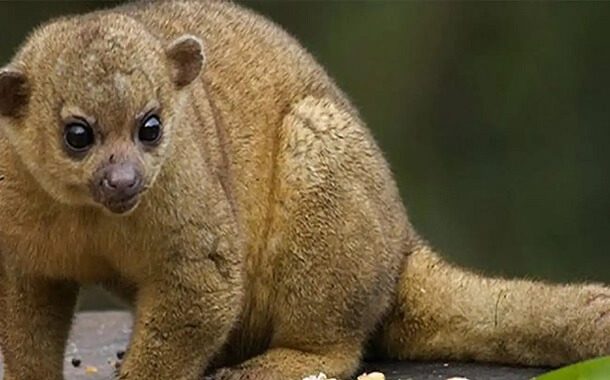How Much Does a Kinkajou Cost?
Last Updated on November 23, 2023
Written by CPA Alec Pow | Content Reviewed by ![]() CFA Alexander Popinker
CFA Alexander Popinker
The kinkajou is an exotic animal native to Central and South America. It looks like a cross between a hamster, a squirrel, and a chinchilla and, due to its cute appearance, it is often kept as a pet.
Kinkajous are more closely related to raccoons than they are to primates. While they share some physical and behavioral characteristics with primates (such as their prehensile tails and arboreal lifestyles), they are not classified as primates. Kinkajou belongs to a different taxonomic group known as the family Procyonidae, which is within the order Carnivora.
How Much Does a Kinkajou Cost?
The average price of a kinkajou would be anywhere between $750 and $3,800. The price of a Kinkajou will be affected by several factors such as the gender of the animal, breeder, age, quality, and the place you buy it from.
Males kinkajou are typically less expensive, around $1,000 to $2,500, while females kinkajou usually cost $2,000 to $3,000 or more. Females are needed for breeding purposes so there is a higher demand.
Regardless of gender, the price of a baby kinkajou under 5 months fetch premium cost range from $2,500 to $5,000.
So while individual pet temperament and genetics impact price somewhat, kinkajou babies and females usually sell for more due to scarcity, breeding potential and high desirability.
According to various online ads, the majority of the prices are anywhere between $450 and $3,500.
From the Julies Jungle website, we found out that the cost of a kinkajou is around $2,500, but this may change.
Kinkajou short presentation
Kinkajous are also known as honey bears because they like to collect honey from bees’ nests with their long, narrow tongues. The name “honey bear” may also refer to the typical golden color of the animal’s soft fur.
They are nocturnal and arboreal wild animals that emerge at night to forage in search of fruit like banana, nectar, ants, honey, flowers, and new growths. They use their tongues and paws to extract food. Their diet makes them an important seed disperser.
A kinkajou has a small head with small ears and relatively large eyes. The body and tail are long and the legs are short. Kinkajous have semi-manipulable hands and feet with sharp claws used for climbing and digging. The coat is golden or brown but sometimes has a gray tint. The animal has soft fur. The teeth and claws are sharp, things a potential kinkajou owner needs to keep in mind.
Kinkajous weighs up to about 18 pounds. Adults range from about sixteen to twenty-two inches in length, not including the tail. The tail is about as long as the rest of the body and helps the animal balance and hang from branches. The kinkajou also wraps its tail around its body to keep warm at night.
They reproduce annually, giving birth to one or two cubs maximum after a gestation of almost 4 months.
They live up to 25 years in captivity.
Additional expenses for a pet kinkajou
In case you purchase your kinkajou from an online breeder that owns exotic animals for sale, or from another state, you should also budget for the shipping fees.
There are states that require a special permit for owning a kinkajou. The cost of such a permit is around $220 per year. Check with your state what’s the permit process and if there are any restrictions.
You should expect to pay around $250 for neutering and spaying.
Also, you need to take into consideration the cost of the regular vet visits which can be around $300+ annually. A kinkajou must be vaccinated every year for different diseases like canine distemper, parvo, and hepatitis. Plus, they require periodic deworming sessions, and dietary supplements not found in natural diet.
You have to trim their non-retractable claws at a vet as well or you can do it yourself if you are comfortable with this.
Kinkajous feed mainly on fruit like figs and melon, leaves, flowers, nectar, and insects. They occasionally eat honey, eggs, and small vertebrates. A few studies have suggested that figs are an important part of the kinkajou’s diet and may make up as much as half of the diet. Depending on the type of food used, you should be prepared to spend a few dollars per day to feed your kinkajou.
You will need an enclosure, like a cage, for your kinkajou which must be made of solid material to prevent damage, have a securable lock, and a minimum of 20 square feet.
They are arboreal creatures, spending most of their lives in trees so, plan on spending at least a few hundred dollars for your pet’s new house. Proper setup is critical and may cost from $500 to $2,000+.
It’s important to note that kinkajous can be challenging to care for as pets due to their specialized dietary and environmental needs.
Important things to consider
 Human-caused habitat destruction has reduced the range and population size of the kinkajou. Deforestation probably accounts for most of the habitat destruction. The IUCN classifies the species as not threatened with extinction, given its wide range and adaptability to a degree of habitat area change. In some areas, kinkajou animals are hunted for their fur or kept as exotic pets.
Human-caused habitat destruction has reduced the range and population size of the kinkajou. Deforestation probably accounts for most of the habitat destruction. The IUCN classifies the species as not threatened with extinction, given its wide range and adaptability to a degree of habitat area change. In some areas, kinkajou animals are hunted for their fur or kept as exotic pets.
Kinkajou breeders in some countries provide pets without harming the wild population and ensure that the domesticated babies are used to humans from an early age.
Kinkajous are usually solitary animals but are occasionally found in groups. They are hard to see in the forest because they spend their lives in the tree canopy and are nocturnal. They are vocal animals, so it is much easier to hear them than to see them.
They mark their territory using the glands on the chest and belly. Usually solitary, they can also be seen in small groups. They are very playful and curious. They cannot bear to be disturbed during the day, their bite being dangerous because the saliva contains a bacterium. They make sounds similar to a woman’s scream.
Kinkajous in captivity
Kinkajous can become very dangerous and can develop aggressive behavior out of the blue. For example, a few years ago, Paris Hilton arrived urgently at the hospital after being attacked, bitten, and scratched out of nowhere by her Kinkajou.
Many Kinkajou owners report that their pets are active, playful, and funny animals once they wake up around 7:00 AM. They also climb and jump over furniture and people. It is important that there is nothing fragile or expensive around a kinkajou.
According to the Chicago Exotic Animal Hospital website, kinkajous are most active between 7 p.m. and midnight. The site also states that it takes two to three hours of daily attention to maintain a bond between a pet kinkajou and humans. This commitment should be kept in mind by anyone who wants to have the animal as a pet, especially if the person has work, family, or personal obligations.
A kinkajou looks very similar to another animal in its family called the olingo. However, an olingo has a longer face and lacks a prehensile tail. Olingos live in the same areas as kinkajous and have similar behaviors, so the two animals are sometimes confused.
It’s important to note that a kinkajou as a pet can be challenging to care for due to their specialized dietary and environmental needs.


Leave a Reply
Want to join the discussion?Feel free to contribute!